RED ARREMER II
( Gargoyle Quest II )
|
|
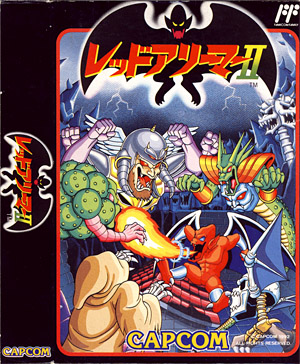
|

|
|
レッドアリーマーII
©Capcom 1992
Release: 1992-07-17 (¥5800)
Cartdridge CAP-1L
Action/Adventure game
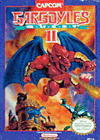

|
Released in America as
GARGOYLE'S QUEST II
( NES-G2-USA )
|
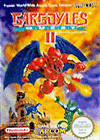

|
Released in Europe as
GARGOYLE'S QUEST II
( NES-G2-XXX )
|
|
Red Arremer II (aka Gargoyle Quest II) is an action/adventure
game by Capcom, and sequel of Red Arremer Makaimura Gaiden originally
released for the Game Boy in 1990. The game follows the story of Firebrand,
a young demon from the Ghoul Realm, who studies to become a powerful warrior.
One day, while training in his hometown of Etruria, a black light suddenly
appears and wrecks havoc on everyone. The king is deadly wounded and Firebrand
embarks on a long journey to solve the mystery of the enigmatic light, and find out who
is behind the attack. In essence, Red Arremer II is an adventure game with mild
RPG elements, punctuated by side-scrolling action phases. The adventure phase is displayed
through a traditional overhead perspective, and Firebrand can walk around, talk to
other monsters, visit houses, purchase items, save his in-game progress (through a password
system) or travel between towns. The side-scrolling action phases are periodically activated
throughout the game, mainly when Firebrand enters a cave or a dungeon, crosses a
bridge or when he encounters rare enemies on the world map. There, he can use his magic
powers to defeat all kind of foes - he starts with traditional Fireballs, but more
abilities can be collected along the way, such as the powerful arc attack, the
platform beam (creates temporary platforms), the Blockbuster (destroys blocks),
the claws (to walk over spikes) and so forth. Another of his incredible abilities is to
jump and stick to walls, and these techniques are at the core of the gameplay - Firebrand
has also the ability to hover in the air for a short amount of time (until his wing level
runs out) in order to reach platforms that are otherwise unattainable, or to avoid deadly hazards.
Finally, numerous items are scattered throughout the game, such as health, extra lives and
Vials (used as currency).
|
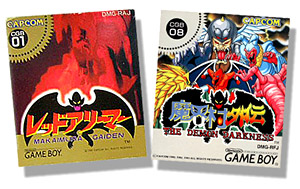 Red Arremer is a spin-off trilogy from the highly acclaimed Makaimura series.
The first episode, Red Arremer Makaimura Gaiden (aka Gargoyle's Quest), was
released for the Game Boy system in 1990 (picture on the right/left). Its sequel, Red Arremer II
(version tested here) was released two years later for the Famicom system. This
sequel is technically a prequel to the first game, and the events depicted there predate
the first episode. It is also really close to the original game but doesn't feature random
enemy battles. Interestingly, a Game Boy version of the game also
exists - Makaimura Gaiden The Demon Darkness was released in 1993 and exclusively
in Japan (picture on the right/right). The last episode was
Demon's Blazon Makaimura Monshō Hen released for
the Super Famicom in 1994.
Red Arremer is a spin-off trilogy from the highly acclaimed Makaimura series.
The first episode, Red Arremer Makaimura Gaiden (aka Gargoyle's Quest), was
released for the Game Boy system in 1990 (picture on the right/left). Its sequel, Red Arremer II
(version tested here) was released two years later for the Famicom system. This
sequel is technically a prequel to the first game, and the events depicted there predate
the first episode. It is also really close to the original game but doesn't feature random
enemy battles. Interestingly, a Game Boy version of the game also
exists - Makaimura Gaiden The Demon Darkness was released in 1993 and exclusively
in Japan (picture on the right/right). The last episode was
Demon's Blazon Makaimura Monshō Hen released for
the Super Famicom in 1994.
|
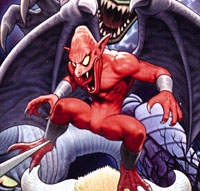 The winged demon Red Arremer (aka Fireband) first appeared in the arcade game
Makaimura (aka Ghosts'n Goblins) originally released in 1986, and it has been one
of Arthur's recurrent nemesis enemy from that point on (the silhouette behind the series's
logo certainly ressembles of Red Arremer). He reappeared in Dai Makaimura
(aka Ghouls'n'Ghosts) released in the arcades in 1988, where he awaits for Arthur
in the second level, sitting on a pile of human skulls. He was then back in service in
Chō Makaimura (aka Super Ghouls 'n Ghosts) released for the Super Famicom
in 1991 - there he attacks Arthur right in the middle of the lava stage. He can also be
found in Arthur and Astaroth's Nazo Makaimura Incredible Toons (Playstation, 1995)
and Goku Makaimara (aka Ultimate Ghosts 'n Goblins) released for the
Playstation Portable in 2006.
Although Red Arremer was featured in his own games from 1990 to 1993, he no longer does.
He continues to make numerous cameo appearances in other Capcom games though - he is one
of the enemy the player encounters in the arcade game Black Dragon (aka Black Tiger)
released in 1987, and in Higemaru Makaijima released for the Famicom the same year.
He also appeared in the SNK vs Capcom: Gekitotsu Card Fighters and in
SNK vs Capcom Chōjō Kessen Saikyō Fighters (Neo Geo Pocket, 1999), and he is a
secret fighter in SNK vs Capcom released in 2003 (arcade, Playstation 2
and Xbox)
The winged demon Red Arremer (aka Fireband) first appeared in the arcade game
Makaimura (aka Ghosts'n Goblins) originally released in 1986, and it has been one
of Arthur's recurrent nemesis enemy from that point on (the silhouette behind the series's
logo certainly ressembles of Red Arremer). He reappeared in Dai Makaimura
(aka Ghouls'n'Ghosts) released in the arcades in 1988, where he awaits for Arthur
in the second level, sitting on a pile of human skulls. He was then back in service in
Chō Makaimura (aka Super Ghouls 'n Ghosts) released for the Super Famicom
in 1991 - there he attacks Arthur right in the middle of the lava stage. He can also be
found in Arthur and Astaroth's Nazo Makaimura Incredible Toons (Playstation, 1995)
and Goku Makaimara (aka Ultimate Ghosts 'n Goblins) released for the
Playstation Portable in 2006.
Although Red Arremer was featured in his own games from 1990 to 1993, he no longer does.
He continues to make numerous cameo appearances in other Capcom games though - he is one
of the enemy the player encounters in the arcade game Black Dragon (aka Black Tiger)
released in 1987, and in Higemaru Makaijima released for the Famicom the same year.
He also appeared in the SNK vs Capcom: Gekitotsu Card Fighters and in
SNK vs Capcom Chōjō Kessen Saikyō Fighters (Neo Geo Pocket, 1999), and he is a
secret fighter in SNK vs Capcom released in 2003 (arcade, Playstation 2
and Xbox)
|
Teaser text copied from the American version:
The law of the claw!
Before Man ruled the world there were
the monsters of Etruria. One such beast
- Firebrand the gargoyle, must act to
restore the magic that quickly fades from
the Ghoul Realm. Join him on his perilous
journey as he looks for the origin of a
mysterious dark beam of light.
Thes epic quest features a hero with
leathery wings and the claws of a lion.
Breathe fire at hideous creatures that
hunger for your essence. Dodge magical
assaults, deadly traps and cunning
opponents that will stop at nothing to
protect their ghastly secret! See if you
have what it takes to solve riddles while
battling for your very life.
|
Game Staff (Copied from the end credits) :
|
Planner
Ryo
Object Designer
Takepong
Katu-M
Wild Cats
Mura
|
|
Scroll Designer
Yuki
Rinda
K.Togo
Joe.Y
|
|
Programmer
Cuty Euyama
Sound Compose
Sato
|
|
CAPCOM
PRESENTS
Saigomade Asondekurete
Dōmo Arigatō
|
|
G
O
O
D
I
E
S
|
|
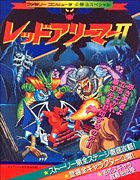
Japanese Guidebook
|
|
|
O
M
A
K
E
|
|
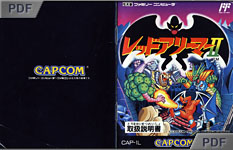
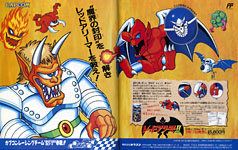
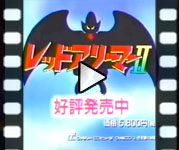
|
|
|
Click on picture to enlarge |
|
|
|
LK

|
|
Add your Pov here !
|
P
O
V
s
|
|
Although he was my most hated character from the Makaimura series
(thanks to his dead swooping attacks), I've always had an odd fascination for
Arremer (aka Firebrand). Despite all the many lives (and coins)
he took from me, I have always felt that Arremer was the only enemy in
the game with its own distinct personality. Capcom, with the Red Arremer
series, gives us an unique insight into what goes behind the scene in the
Ghoul Realm, which is frankly genius. Most of Arthur's enemies
can be seen in their natural habitats - zombies, mummies, demons and so forth.
The game looks superb, everything is finely polished with an incredible attention
to detail. The overworld is probably the weakest link, but it plays a minor role
and the game mainly focuses on the side-scrolling action scenes, and the change of
pace keeps the player continually engaged. My only gripe with Red Arremer II
is the difficulty level - well, the Makaimura series is notoriously difficult,
controls (especially the flying ability) take some time to get used to, and some
stages are painfully frustrating. Everything kills you in this game, even platforms
shoot at you! All in all, Red Arremer II is an awesome and fun game, but be
aware of its sheer difficulty (not as bad as other early Makaimura games though).
|
|
|
|